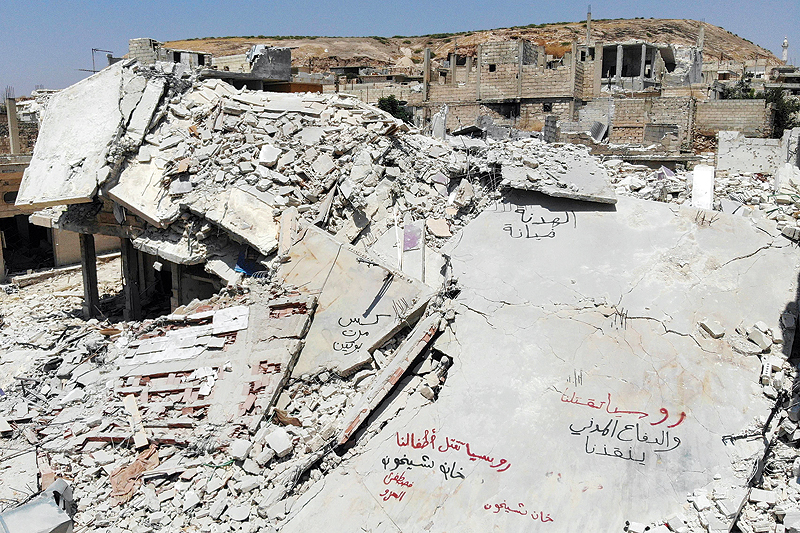Regime advances after scrapping northwest Syria truce
WASHINGTON: The Islamic State (IS) jihadist group was "resurging" in Syria while the United States withdrew troops, and has solidified its insurgent capabilities in neighboring Iraq, a Defense Department watchdog said yesterday. The jihadists-who suffered major territorial losses at the hands of Iraqi and Syrian forces backed by a US-led international air campaign-are exploiting weaknesses in local forces to make gains, the report from the Office of Inspector General said.
"Despite losing its territorial 'caliphate,' the Islamic State in Iraq and Syria (ISIS) solidified its insurgent capabilities in Iraq and was resurging in Syria this quarter," according to the report, which uses an alternate name for the jihadist group. IS has been able to "regroup and sustain operations" in the two countries partially because local forces "remain unable to sustain long-term operations, conduct multiple operations simultaneously, or hold territory that they have cleared," the report said.
The group's Syria resurgence came as Washington "completed a partial withdrawal" from the country, a move made despite commanders saying that the local US-backed Syrian Democratic Forces (SDF) "needed more training and equipping for counterinsurgency operations." Last year, US President Donald Trump declared victory against IS and ordered the withdrawal of all American troops from Syria-a decision that prompted then defense secretary Jim Mattis to quit.
'Create turmoil'
A small number of American troops have remained in northeastern Syria, an area not controlled by the regime of President Bashar Al-Assad, and Washington is pushing for increased military support from other members of the international coalition against IS. IS jihadists have carried out targeted assassinations, ambushes and suicide bombings in both countries and in Iraq have "established a more stable command and control node and a logistics node for coordination of attacks," the report said. The group's strategy in the two countries is to "create turmoil in territory it has lost" and prevent local security forces "from establishing effective control and maintaining civil order."
The US-led coalition against IS believes the jihadist group likely has between 14,000 and 18,000 "members" in Iraq and Syria, among them up to 3,000 foreigners, the report said. IS has suffered major losses, but its predecessor the Islamic State of Iraq likewise appeared on the ropes after Sunni Muslim tribesmen turned against the jihadists, combining with the US "surge" of troops in 2007-2008 to deal them a body blow.
Abu Bakr Al-Baghdadi was however able to revive the extremists' fortunes, drawing on subsequent widespread Sunni anger with Iraq's Shiite-led government to rebuild, aided by the chaos and violence of the Syrian civil war. The jihadists seized control of large parts of Syria and Iraq, declaring an Islamic "caliphate" in 2014 and committing widespread atrocities, and were only pushed back after multiple years of heavy fighting and a massive US air campaign.
Regime advances
Meanwhile, regime loyalists captured a town and a village from jihadists and allied rebels in northwest Syria Wednesday, after fierce clashes that killed nearly 30 combatants overnight, a war monitor said. The town of Al-Zakat and the Al-Arba'een village in Hama province came under regime control on Wednesday morning, the Syrian Observatory for Human Rights said. It said the clashes overnight killed 10 regime loyalists and 18 opposition fighters, including 13 jihadists. The push has also seen regime loyalists reach the edges of Kafr Zita and Al-Latamneh - respectively, a major town and a village - held by the opposition in northern Hama, according to the Observatory.
Hayat Tahrir al-Sham (HTS), a jihadist group led by Syria's former Al-Qaeda affiliate, has since January controlled Northern Hama as well as all of Idlib and adjacent parts of Aleppo and Latakia governorates. A truce that started on Friday was supposed to protect three million people living in the region after three months of deadly bombardment by the regime and its ally Russia. But HTS on Saturday refused to comply with a key condition to that truce, declaring it would never withdraw from a planned buffer zone around the area.
On Monday, the government declared the truce over, accusing its opponents of attacking civilian areas and bombarding an air base of its ally Russia. Moscow and Damascus have since resumed air strikes. "The regime leveraged the ceasefire to send reinforcements to Northern Hama," said Rami Abdul Rahman, the head of the Britain-based monitor. A Turkish-Russian deal struck in September last year was supposed to avert a massive government offensive on the Idlib region.
But that deal was never fully implemented as jihadists refused to withdraw from the planned demilitarized cordon. Instead, heightened attacks by the regime and Russia have killed more than 800 civilians since the end of April, the Observatory says. It has also pushed 400,000 people from their homes, according to the UN. Syria's conflict has killed more than 370,000 people and driven millions from their homes since it started with the brutal repression of anti-government protests in 2011.- Agencies










